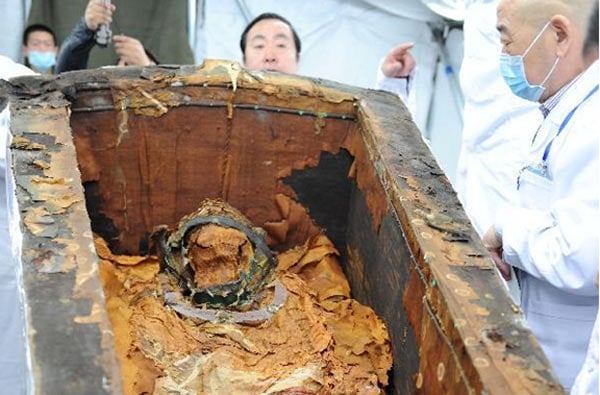Chinese archaeologists rescued an ancient coffin from tomb raiders trying to break in to a grave site via a 10 metre hole in a pasture region of China’s Inner Mongolia Autonomous Region. The 1,500-year-old coffin contained the silk-wrapped body of an aristocratic woman.

Archaeologists carefully opened the black lacquer pinewood coffin last Saturday and found the remains of a woman with thick black hair wearing a metal headband and fur boots, along with a number of grave goods, including a bow, dagger, pottery jars and bowls. The coffin was covered with silk curtains hanging from a bronze dragon head in the centre of the tomb chamber.

Scientists inspect the newly opened coffin. Photo credit: News.CN
The coffin dates to the Northern Wei Dynasty (386 – 535 AD). Described as “part of an era of political turbulence and intense social and cultural change”, the Northern Wei Dynasty is particularly noted for unifying northern China in 439: this was also a period of introduced foreign ideas; such as Buddhism, which became firmly established.
While the identity of the tomb owner is unknown, archaeologists suspect the woman belonged to the Xianbei ethnic group, nomadic people that used to dominate the northern prairie. Scientists will carry out an analysis to learn more about the woman.
Zhuang Yongxing, deputy head of the cultural bureau in Xilin Gol City, said that archaeologists performed a rescue excavation of the tomb after tomb raiders were caught digging a 10-meter-deep hole toward the tomb entrance. Tomb raiding is a huge problem in China where thieves are using increasingly aggressive and sophisticated methods to extract the wealth of relics buried underground from China’s ancient civilizations, including dynamite and even bulldozers. Artefacts are then sold on the black market within days to international dealers.